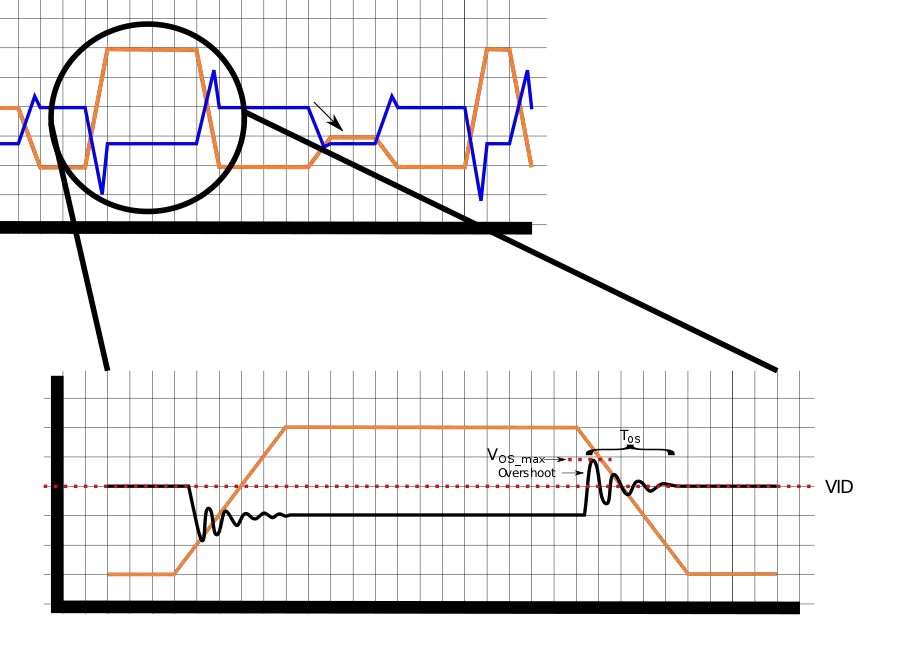Load-Line Calibration (LLC) is a mechanism offered to overclockers designed to compensate for large voltage droops when a CPU or GPU is under increased load. The mechanism attempts to compensate for the sudden sagging in voltage by preemptively applying additional voltage. The LLC, which is part of the voltage regulator module, was introduced in order to ensure a more smooth voltage delivery when the CPU/GPU is both idle as well as under heavy load, thereby eliminating related system instability or crashes on overclocked systems. This feature is aimed at overclockers as for normal systems the LLC is usually disabled by default because typical Vdroop is part of the system specification.
- Note: While extremely helpful at times, load-line calibration must be used with extreme care!
Overview[edit]
A modern computer system is never constant. To be more efficient and performant, the CPU will hop between very low and very high clock frequencies depending on how demanding the workload being executed is. Often this can be done very rapidly as the CPU is racing to sleep. When nothing is effectively being executed and the CPU is idle, the current is also relatively low. However, when the CPU is under load and the frequency shoots up, so will the current. An example graph is shown below.
On a system with a static PWM Controller driving the voltage regulator module, the stored energy is constant. When the system goes from idle into being under load, there is no sufficient amount of energy to maintain the predefined voltage, causing a voltage drop. For example, a VRM operating at a constant 10% duty cycle delivering 1.2 V at idle will look like this:
To prevent such drops, most modern VRMs have some form of feedback used to sense the voltage and current. When that happens, the circuits attempts to compensate for it by adjusting the duty cycle. For example, suppose the VRM that was previously shown dynamically adjusts to 12% duty cycle from 10% when it detects a drop, the voltage change would look similar to this:
It can be seen that the voltage under load is now considerably better than it was previously, allowing it to maintain a steady voltage for when it's both ideal and under load.
Overshoot[edit]
There is an obvious problem with this kind of technique and that is overshooting. When the PWM Controller senses added load and voltage drop, it will attempt to compensate for it by increasing the duty cycle. However, when the processor goes back to idle, since the controller cannot predict the future, there will be a delay until the PWM senses another drop and readjusts the duty cycle back down. Therefore, for a short period of time when the load current dropped, there will be a spike in voltage.
This spike, called an overshoot, exceeds the desired reference voltage. A spike in voltage that is too great will degrade the transistors on the chip. Extremely high voltage will cause a catastrophic breakdown of transistors. Companies such as Intel publish VRM specifications that specify what's the maximum allowed overshot voltage (VOS_max) and for how long it's allowed (TOS). Since motherboard manufacturers cannot exceed those ratings, there's a limit as to how high they can change the duty cycle before you exceed those ratings. Therefore it's natural for VRMs to have a certain amount of Vdroop in order to make sure they do not exceed the allowed overshoot voltage. In other words, Vdroop is intentionally added in order to prevent a voltage overshoot that is harmful to the CPU.
Reducing overshoot[edit]
There are various ways to reduce the overshoot on modern systems. The easiest way is to use bigger components that can store more energy - and although this will work, the efficiency is reduced. A better approach is that the PWM Controller frequency and sampling rate can be increased. With increased sampling rate, it can compensate for voltage spikes much quicker before it spikes all the way up. It's worth pointing that increasing the switching frequency affects the circuit - the MOSFETs need to be able to keep up with the frequency, also the very high-end PWM Controllers become too expensive to use on motherboards. Eventually the design decisions boil down to a compromise.
Load-Line Calibration[edit]
An overclocked system might have be using relatively high voltage settings. When the idle voltage is higher, the voltage droop itself is greater during full load by the CPU. In order to prevent system instability due to large voltage droops as a result of overclocking, many motherboards come with a load-line calibration settings. Applying LLC voltage will allow the VRM to apply higher voltage when it senses higher load. In other words, the LLC adjusts the amount of Vdroop the VRM is expected to experience when going from full idle to full load.
It's important to note that LLC has very significant impact on the overshoot voltage, therefore it's usually best to be very conservative in how much LLC offset voltage is being applied. The exact impact and overshoot will highly depend on the motherboard and on the PWM and VRM circuits and how well they can sense and react to voltage and current changes. A good PWM that's fast and can react well will adjust fast enough before the maximum overshoot is even reached allowing to adjust the LLC further. Choose the right configuration will largely depend on the motherboard capabilities.
Extreme LLC[edit]
Some motherboards offer an "Extreme" or "Ultra-High" LLC settings that will actually deliver higher voltage than in ideal, leading to high overshoots (depending on motherboard). Generally speaking, no one other than extreme overclockers (e.g., LN2 overclockers, people who disable C-States, etc..) should be using this - those people know who they are.





